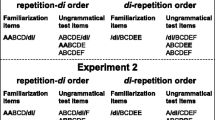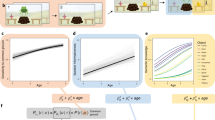Abstract
It has been reported in the literature that both adults and children can, to a different degree, modify and regularize the often-inconsistent linguistic input they receive. We present a new algorithm to model and investigate the learning process of a learner mastering a set of (grammatical or lexical) forms from an inconsistent source. The algorithm is related to reinforcement learning and drift–diffusion models of decision making, and possesses several psychologically relevant properties such as fidelity, robustness, discounting, and computational simplicity. It demonstrates how a learner can successfully learn from or even surpass its imperfect source. We use the data collected by Singleton and Newport (Cognit Psychol 49(4):370–407, 2004) on the performance of a 7-year-boy Simon, who mastered the American Sign Language (ASL) by learning it from his parents, both of whom were imperfect speakers of ASL. We show that the algorithm possesses a frequency boosting property, whereby the frequency of the most common form of the source is increased by the learner. We also explain several key features of Simon’s ASL.





Similar content being viewed by others
References
Abney S (2011) Statistical methods in language processing. Wiley Interdiscip Rev Cognit Sci 2(3):315–322
Andersen RW (1983) Pidginization and creolization as language acquisition. ERIC, Rowley
Bogacz R, Brown E, Moehlis J, Holmes P, Cohen JD (2006) The physics of optimal decision making: a formal analysis of models of performance in two-alternative forced-choice tasks. Psychol Rev 113(4):700
Bresnan J, Cueni A, Nikitina T, Baayen RH et al (2007) Predicting the dative alternation. Cognitive Foundations of Interpretation, Amsterdam, pp 69–94
Brighton H (2002) Compositional syntax from cultural transmission. Artif Life 8(1):25–54
de Marneffe M-C, Grimm S, Arnon I, Kirby S, Bresnan J (2012) A statistical model of the grammatical choices in child production of dative sentences. Lang Cognit Process 27(1):25–61
Griffiths TL, Kalish ML (2007) Language evolution by iterated learning with Bayesian agents. Cognit Sci 31(3):441–480
Hsu AS, Chater N, Vitányi P (2013) Language learning from positive evidence, reconsidered: a simplicity-based approach. Top Cognit Sci 5(1):35–55
Hudson Kam CL, Newport EL (2005) Regularizing unpredictable variation: the roles of adult and child learners in language formation and change. Lang Learn Dev 1(2):151–195
Hudson Kam CL, Newport EL (2009) Getting it right by getting it wrong: When learners change languages. Cognit Psychol 59(1):30
Kirby S (1999) Function, selection, and innateness: the emergence of language universals. OUP, Oxford
Kirby S (2001) Spontaneous evolution of linguistic structure–an iterated learning model of the emergence of regularity and irregularity. Evol Comput IEEE Trans 5(2):102–110
Kirby S, Smith K, Brighton H (2004) From UG to universals: linguistic adaptation through iterated learning. Stud Lang 28(3):587–607
Kroch A (1989) Reflexes of grammar in patterns of language change. Lang Variat Change 1(3):199–244
Kroch A, Taylor A (1997) Verb movement in Old and Middle English: dialect variation and language contact. In: Parameters of morphosyntactic change. Cambridge University Press, Cambridge, pp 297–325
Lee D, Seo H, Jung MW (2012) Neural basis of reinforcement learning and decision making. Ann Rev Neurosci 35:287–308
Lieberman E, Michel J-B, Jackson J, Tang T, Nowak MA (2007) Quantifying the evolutionary dynamics of language. Nature 449(7163):713–716
Maia TV (2009) Reinforcement learning, conditioning, and the brain: successes and challenges. Cognit Affect Behav Neurosci 9(4):343–364
Marchman VA, Plunkett K, Goodman J (1997) Overregularization in English plural and past tense inflectional morphology: a response to Marcus. J Child Lang 24:767–779
Marcus GF (1995) Children’s overregularization of English plurals: a quantitative analysis. J Child Lang 22:447
Marcus GF, Pinker S, Ullman M, Hollander M, Rosen TJ, Xu F, Clahsen H (1992) Overregularization in language acquisition. Monogr Soc Res Child Dev 57:1–178
Monaghan P, White L, Merkx MM (2013) Disambiguating durational cues for speech segmentation. J Acoust Soc Am 134(1):EL45–EL51
Niyogi P (2006) The computational nature of language learning and evolution. MIT Press, Cambridge
Norman M (1972) Markov processes and learning models. Academic Press, New York
Nowak MA, Komarova NL, Niyogi P (2001) Evolution of universal grammar. Science 291(5501):114–118
Pearl L, Weinberg A (2007) Input filtering in syntactic acquisition: answers from language change modeling. Lang Learn Dev 3(1):43–72
Perfors A, Tenenbaum JB, Regier T (2011) The learnability of abstract syntactic principles. Cognition 118(3):306–338
Plunkett K, Juola P (1999) A connectionist model of English past tense and plural morphology. Cognit Sci 23(4):463–490
Ratcliff R, Rouder JN (1998) Modeling response times for two-choice decisions. Psychol Sci 9(5):347–356
Reali F, Griffiths TL (2009) The evolution of frequency distributions: relating regularization to inductive biases through iterated learning. Cognition 111(3):317–328
Roy DK, Pentland AP (2002) Learning words from sights and sounds: a computational model. Cognit Sci 26(1):113–146
Sebba M (1997) Contact languages: Pidgins and Creoles. Macmillan, London
Seidl A, Johnson EK (2006) Infant word segmentation revisited: edge alignment facilitates target extraction. Dev Sci 9(6):565–573
Senghas A (1995) The development of Nicaraguan Sign Language via the language acquisition process. In: Proceedings of the 19th annual Boston University conference on language development, pp 543–552
Senghas A, Coppola M (2001) Children creating language: how Nicaraguan Sign Language acquired a spatial grammar. Psychol Sci 12(4):323–328
Senghas A, Coppola M, Newport EL, Supalla T (1997) Argument structure in Nicaraguan Sign Language: the emergence of grammatical devices. In: Proceedings of the 21st annual Boston University conference on language development, vol 2, pp. 550–561
Singleton JL, Newport EL (2004) When learners surpass their models: the acquisition of American Sign Language from inconsistent input. Cognit Psychol 49(4):370–407
Smith PL (2000) Stochastic dynamic models of response time and accuracy: a foundational primer. J Math Psychol 44(3):408–463
Smith K, Wonnacott E (2010) Eliminating unpredictable variation through iterated learning. Cognition 116(3):444–449
Smith K, Kirby S, Brighton H (2003) Iterated learning: a framework for the emergence of language. Artif Life 9(4):371–386
Steels L (2000) Language as a complex adaptive system. In: Parallel problem solving from nature PPSN VI, Springer, Berlin, pp 17–26
Sutton RS, Barto AG (1998) Reinforcement learning: an introduction. Cambridge University Press, Cambridge
Thomason SG, Kaufman T (1991) Language contact, creolization, and genetic linguistics. University of California Press, Berkeley
Author information
Authors and Affiliations
Corresponding author
Rights and permissions
About this article
Cite this article
Mandelshtam, Y., Komarova , N.L. When Learners Surpass Their Models: Mathematical Modeling of Learning from an Inconsistent Source. Bull Math Biol 76, 2198–2216 (2014). https://doi.org/10.1007/s11538-014-9990-2
Received:
Accepted:
Published:
Issue Date:
DOI: https://doi.org/10.1007/s11538-014-9990-2




